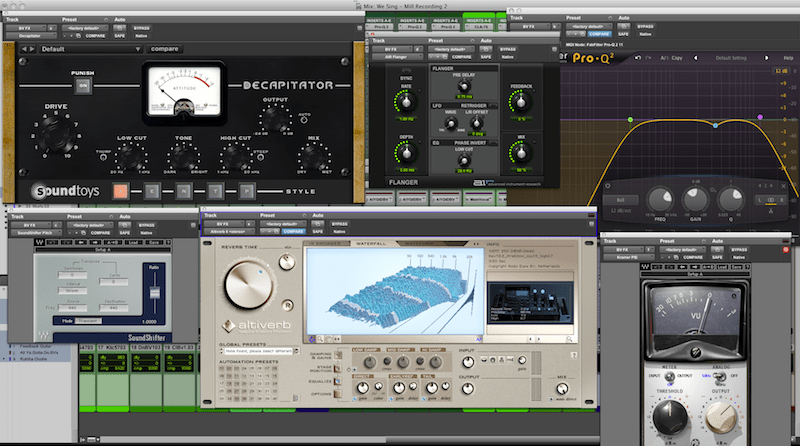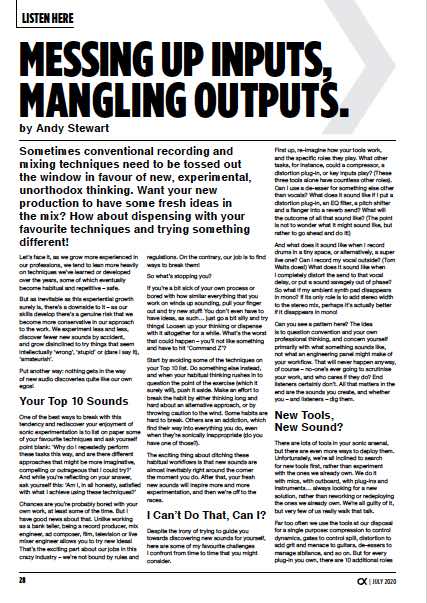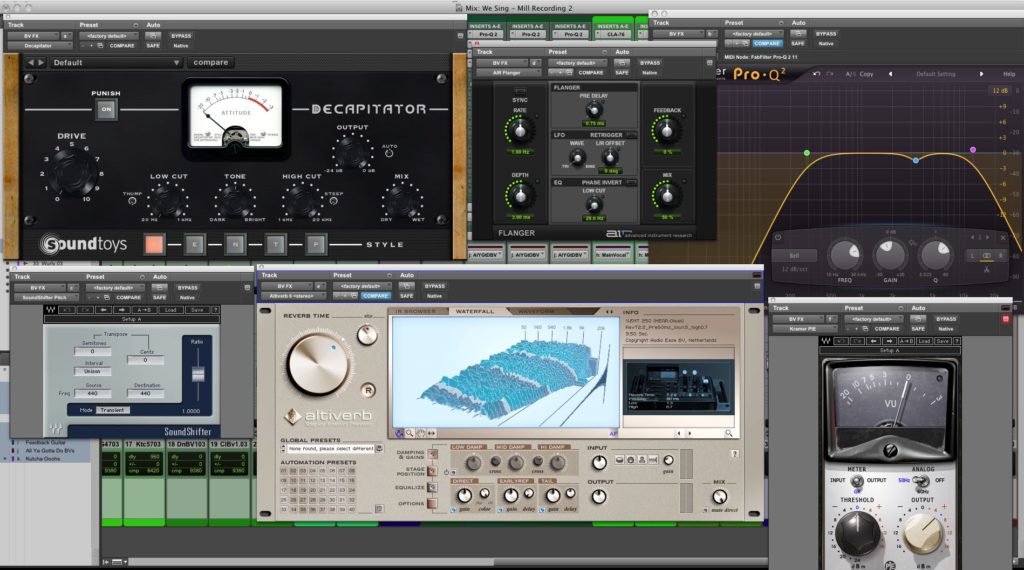News
15 Jul 2020
Messing Up Inputs, Mangling Outputs

Subscribe to CX E-News
Sometimes conventional recording and mixing techniques need to be tossed out the window in favour of new, experimental, unorthodox thinking. Want your new production to have some fresh ideas in the mix? How about dispensing with your favourite techniques and trying something different!
Let’s face it, as we grow more experienced in our professions, we tend to lean more heavily on techniques we’ve learned or developed over the years, some of which eventually become habitual and repetitive – safe. But as inevitable as this experiential growth surely is, there’s a downside to it – as our skills develop there’s a genuine risk that we become more conservative in our approach to the work.
We experiment less and less, discover fewer new sounds by accident, and grow disinclined to try things that seem intellectually ‘wrong’, ‘stupid’ or (dare I say it), ‘amateurish’. Put another way: nothing gets in the way of new audio discoveries quite like our own egos!
Your Top 10 Sounds
One of the best ways to break with this tendency and rediscover your enjoyment of sonic experimentation is to list on paper some of your favourite techniques and ask yourself point blank: ‘Why do I repeatedly perform these tasks this way, and are there different approaches that might be more imaginative, compelling or outrageous that I could try?’
And while you’re reflecting on your answer, ask yourself this: ‘Am I, in all honesty, satisfied with what I achieve using these techniques?’
Chances are you’re probably bored with your own work, at least some of the time. But I have good news about that. Unlike working as a bank teller, being a record producer, mix engineer, ad composer, film, television or live mixer engineer allows you to try new ideas!
That’s the exciting part about our jobs in this crazy industry – we’re not bound by rules and regulations. On the contrary, our job is to find ways to break them! So what’s stopping you?
If you’re a bit sick of your own process or bored with how similar everything that you work on winds up sounding, pull your finger out and try new stuff! You don’t even have to have ideas, as such… just go a bit silly and try things! Loosen up your thinking or dispense with it altogether for a while. What’s the worst that could happen – you’ll not like something and have to hit ‘Command Z’?
Start by avoiding some of the techniques on your Top 10 list. Do something else instead, and when your habitual thinking rushes in to question the point of the exercise (which it surely will), push it aside. Make an effort to break the habit by either thinking long and hard about an alternative approach, or by throwing caution to the wind.
Some habits are hard to break. Others are an addiction, which find their way into everything you do, even when they’re sonically inappropriate (do you have one of those?). The exciting thing about ditching these habitual workflows is that new sounds are almost inevitably right around the corner the moment you do. After that, your fresh new sounds will inspire more and more experimentation, and then we’re off to the races.
I Can’t Do That, Can I?
Despite the irony of trying to guide you towards discovering new sounds for yourself, here are some of my favourite challenges I confront from time to time that you might consider.
First up, re-imagine how your tools work, and the specific roles they play. What other tasks, for instance, could a compressor, a distortion plug-in, or key inputs play? (These three tools alone have countless other roles).
Can I use a de-esser for something else other than vocals? What does it sound like if I put a distortion plug-in, an EQ filter, a pitch shifter and a flanger into a reverb send? What will the outcome of all that sound like? (The point is not to wonder what it might sound like, but rather to go ahead and do it!)
And what does it sound like when I record drums in a tiny space, or alternatively, a super live one? Can I record my vocal outside? (Tom Waits does!) What does it sound like when I completely distort the send to that vocal delay, or put a sound savagely out of phase? So what if my ambient synth pad disappears in mono? If its only role is to add stereo width to the stereo mix, perhaps it’s actually better if it disappears in mono!
Can you see a pattern here? The idea is to question convention and your own professional thinking, and concern yourself primarily with what something sounds like, not what an engineering panel might make of your workflow. That will never happen anyway, of course – no-one’s ever going to scrutinise your work, and who cares if they do? End listeners certainly don’t. All that matters in the end are the sounds you create, and whether you – and listeners – dig them.
New Tools, New Sound?
There are lots of tools in your sonic arsenal, but there are even more ways to deploy them. Unfortunately, we’re all inclined to search for new tools first, rather than experiment with the ones we already own. We do it with mics, with outboard, with plug-ins and instruments… always looking for a new solution, rather than reworking or redeploying the ones we already own. We’re all guilty of it, but very few of us really walk that talk.
Far too often we use the tools at our disposal for a single purpose: compression to control dynamics, gates to control spill, distortion to add grit and menace to guitars, de-essers to manage sibilance, and so on. But for every plug-in you own, there are 10 additional roles each of them could play that would transform your sonic palette.
The idea is to question convention and your own professional thinking, and concern yourself primarily with what something sounds like, not what an engineering panel might make of your workflow
The trick is to mix things up. Why not add some extra layers of plug-ins to your auxiliary chain prior to the main element, whether that be a reverb, a parallel bus or whatever. That way the feed-in signal will be transformed before it arrives at its destination. Now let’s add something else after the main element.
Why not? You could add a compressor after the reverb output and use that to expand the reverb? Woah, that sounds wrong, doesn’t it… until you feed the original vocal into the compressor’s key input. Now the reverb is being subdued by the vocal til the end of the delivery, at which point, the reverb leaps forward to emphasise the space! Cool!
Something Borrowed, Something New
How about setting yourself the challenge of adding at least two new sounds to your next mix that are the direct result of throwing caution to the wind. It might be the way you record the piano, or you might decide to record a mono drum kit via a single ribbon overhead that’s heavily compressed, rather than placing 16 mics around the room.
You might specifically choose not to use reverb on sounds that are typically wet in your mix, and instead add it to the stuff that’s normally dry.
Next up, listen to some music in your studio one evening, from any decade or genre, and pick a favourite sound. Scrutinise that sound and try to determine how it was forged. Now try to copy it. It may not work in the song you’re currently producing, but it may lead you down a road you would otherwise never travel. That is never time wasted, and almost always leads to a cool new discovery of your own.
Very few truly great audio productions are made with safety in mind. When you’re an engineer or producer it pays to experiment at least some of the time, casting safety aside in the pursuit of something unpredictable and new. Sure, there are no guarantees this will always work, but that’s okay. There are no guarantees playing it safe will either.
Andy Stewart owns and operates The Mill on Victoria’s Bass Coast. He’s a highly credentialed producer/engineer who’s seen it all in studios for over three decades. He’s happy to respond to any pleas for recording or mixing help… contact him at: andy@themill.net.au
CX Magazine – July 2020
LIGHTING | AUDIO | VIDEO | STAGING | INTEGRATION

Entertainment technology news and issues for Australia and New Zealand
– in print and free online www.cxnetwork.com.au
© VCS Creative Publishing
Subscribe
Published monthly since 1991, our famous AV industry magazine is free for download or pay for print. Subscribers also receive CX News, our free weekly email with the latest industry news and jobs.






